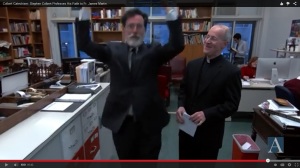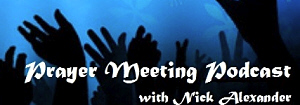What the Stephen Colbert Interview Illuminates About Worship Music
Did you see this interview? Fr. James Martin, editor of America magazine, takes Stephen Colbert aside and asks him some simple questions about his faith. I am particularly interested in the exchange that begins at 5:11.
Favorite Hymn? Favorite Catholic Hymn?
Uh, um… Here I Am Lord, that’s a pretty good one. Um, I like “Here I Am Lord.”
I like “O Come O Come Emmanuel”, that’s good. It’s Christmassy but it’s bigger than that…”Bigger than that, what do you mean?” It’s more resonant than just the season.
Do you like all the 60s hymns like “Sons of God” and all of that?
“Our Father, whom art in heaven, Hallowed be Thy Name…”
Do you like that?
Nope. Not at all. I am not a big guitar mass sort of person.
Do you like “Sons of God”? Remember that one?
What’s that?
“Sons of God, hear His holy Word. Gather…” You don’t know that?
Don’t remember that one.
“The King of Glory comes the nation rejoices, open the gates before Him lift up your voices…” (starts dancing).
“Who is the King of glory, how shall we call Him? He is Emmanuel the promised of ages.” That’s probably my …
Do you know the second verse, though?
No.
Oh, let’s see. Uh. “In all of Galilee in city or village, He goes among the people curing their illness.”
Of course, the fact of illness and village? That’s what I like about that.
That’s one of the miracles! That’s one of the miracles of our Lord, rhyming “illness” and “village.”
The part where he dances to “The King of Glory”? That is a throwback, before The Daily Show, when he was a regular on “Strangers With Candy.” Here is the snippet worth watching:
Is there any viral clip out there that better distinguishes the state of music in Catholic worship today, in contrast with those of different denominations or styles?
What gets me about this interview is that, while it is evident that both Fr. Martin and Stephen Colbert are clearly brilliant Catholic intellectuals, they are hung up over songs from a brief period–about two decades worth–in contrast to the span of thousands of years. (And if you have doubts about Colbert’s knowledge of the faith, check out this famous interview with atheist Philip Zimbardo… harsh language warning).
The Current State of Catholic Hymnody
This is the current state of Catholic hymnody. In short, when Vatican II transpired, there was a brief period when worship songs came forth from folk musician songwriters through the guitar. The most recent song from Colbert’s list is “Here I Am Lord”, written in 1984. That was over thirty years ago.
I find it interesting that Fr. Martin was transfixed over the song “Sons of God”, which, to credit modern-day missalette houses, I have not found in any recent worship publication. (Correct me if I am wrong).
In contrast, compare this to both worship traditionalists and worship contemporaries.
Traditional Hymns
There are churches that are bound by the hymnal (which, to their credit, a hymnal is one of the greatest worship aids there is). A typical hymnal has about four hundred songs, many of which are compartmentalized by liturgical season or theme. In my experience, a worship musician that is bound to such songs only uses a fraction of the book’s contents, which leads to the same songs being played time and again, not introducing the congregation to the fullness of the contents. I once asked an organist, who had previously boasted about playing the organ for well over forty years, if he had considered playing a specific song in the hymnal… “If I know it” was his response… as if forty years was not enough to know every single song in a book.
The problem with playing the same songs to congregants? The songs become dulled by overuse. Yeah, I remember when I first heard “Here I Am Lord,” and was really overjoyed by the song. But now it’s just same-old, same-old.
In fairness to Catholic missallette publishing houses (and places like SpiritandSong and World Library’s “Voices As One” series), they really do try to introduce new songs to the congregation. Being that both Colbert and Fr. Martin are oblivious to such songs tells me more about the effecaciousness of the current offerings, or the dominance of songs one heard when one was much younger in one’s memory, than the effect of such songs.
Chants
Now… if I want to take that even back further, Chants as dictated by the Roman Gradual… not congregational-friendly, not even in English, but certainly very worshipful. To be fair, there are different levels of chant… the ones from the Gradual Simplex are certainly easier for an average congregant to pick up than the complex ones from the Gradual itself… but-centuries in existence notwithstanding-these are also somewhat disposable. Congregants do not leave the parish singing the chant that they just sang for the first time. And such chants, in my experience, do not take residence in one’s memory.
Contemporary Worship Songs
By further contrast, worship contemporaries are bound by what is popular today, as dictated by Christian radio and the CCLI charts. Songs rise and fall with the times, become extremely popular in short order, only to lose favor as time passes and the latest albums get released. Spotify playlist
There are great songs here too, but they are performed by professional singers. The vast majority of such songs are dominated by inconsistent melodic riffs dominated by sixteenth and thirty-second notes, not to mention a musical range that goes well and beyond outside the confines of a non-trained singer.
As a result, most of the congregation (by and large) will not sing along except during the chorus and the overly repetitious outro.
What Worship Can Be (And is Currently Not)
The point here is that I can envision and dream of churches being revitalized by song, by singing congregations. A parish who sings can grow to love God in their heart, and in action, but not merely be a passive pew-sitter. As one sings, the words become part of a person’s intellect, combined with a melody that inspires the heart. And as evidenced, this can take root and be vivid, decades after the fact, even after some songs are no longer included in current publishing materials.
I envision a worship format that has no boundaries when it comes to worship style. I anticipate a time where traditional hymns, ancient chants, and modern-day choruses (and nearly every song inbetween) be utilized, complementing each other in tone, in singability, in orthodoxy, and in lyrical emphasis.
But as it stands right now, a typical church employs either worship songs that are dated, or dulled by overuse, or inaccessible by an average congregant. Whether ancient, hymn-specific, contemporary, or frozen in time, nobody is singing much in churches nowadays.
What are your thoughts about the state of worship music in your church?











Oh boy. Another celebrity Catholic who no doubt supports abortion.
Our previous Dir of Music played mostly contemporary with some traditional hymns. The current one plays mostly hymns, a few contemporary, and some plainchant (Agnus Dei, Gloria, etc.). People have complained about both styles. Oy!
Oy indeed! There will never be pleasing of every parishioner, but I can fully get behind a music director who goes in that direction.